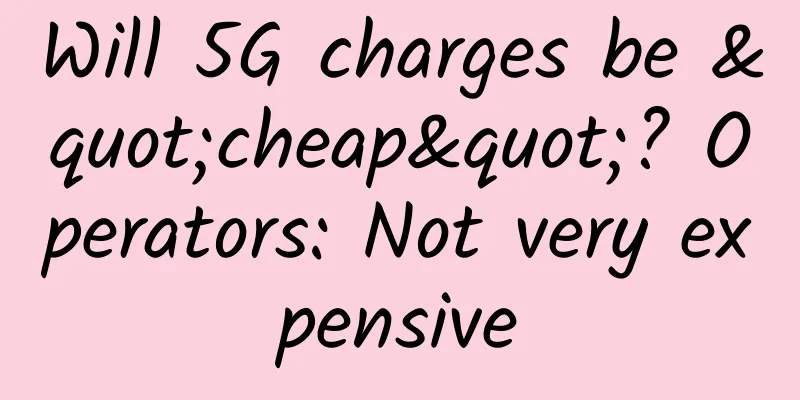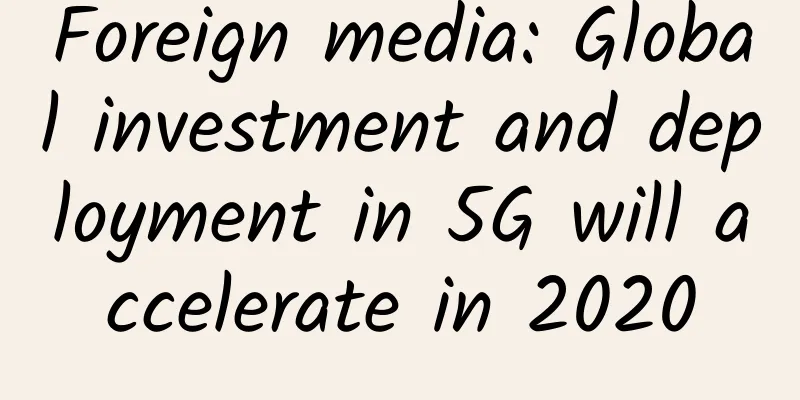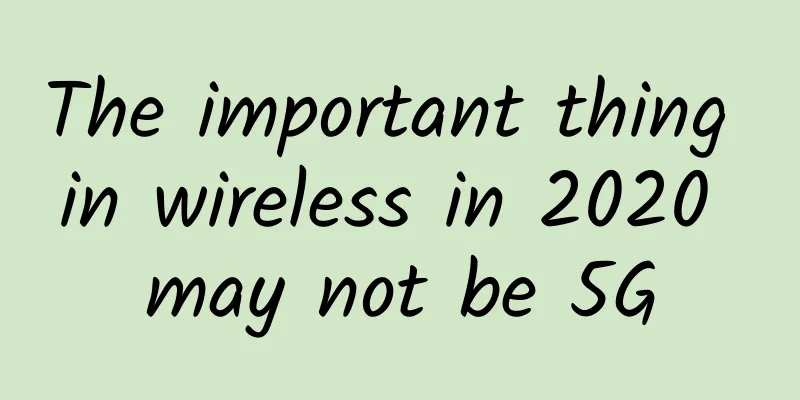Will 5G charges be "cheap"? Operators: Not very expensive

|
From the issuance of 5G commercial licenses to the launch of the first batch of 5G mobile phones, everyone is looking forward to the new 5G era. It is reported that domestic 5G tariff packages will be launched as early as August, and are expected to be lower than the 4G tariff level. Will 5G tariffs be "cheap"? At present, the three major operators have opened 5G test points in many cities across the country. Although there are no official 5G packages on the market, the operators have responded to the 5G traffic billing issue that the public is concerned about. Operators: 5G charges will not be expensive China Mobile announced the "5G test unified package" in June, which includes 200G traffic, 1,000 minutes of voice calls, and 100 text messages per month. The package has the characteristics of "two no and one more", that is, no need to change the card, no need to change the number, and more applications, allowing customers to choose and combine freely. However, this package is only for China Mobile's 5G friendly customers to test, and the price has not been announced. China Unicom's initial plan is to adopt and innovate the 5G charging model for the consumer market and 4G products, with traffic being one of the important factors to be considered, and to study new charging models based on the technical characteristics of 5G services. For the government and corporate customer markets, more personalized and scenario-based 5G services will be provided in combination with network construction, and diversified charging models based on scenarios will be introduced according to customer needs and one customer one policy. China Telecom's 5G packages are also being designed and deployed, and will follow a multi-dimensional billing model. In short, the signal given by the operator is that 5G charges will not be expensive and everyone can afford it. Zhu Guosheng, vice chairman of the 5G network service quality special topic of the International Telecommunication Union, said in an interview with this newspaper that my country's early 5G tariff packages are likely to allow users to continue using 4G traffic packages, and then give away some 5G traffic on this basis for users to experience first. "At present, the three major operators are actively transforming themselves from network plumbers to information service providers. When this transformation is completed, the operators will make profits through information services, and the charges will be very cheap, or even free." Zhu Guosheng believes that, for now, it will take some time to complete this transformation. Consumers: Looking forward to continued speed increases and fee reductions At China Unicom's 5G experience flagship store on Beijing Financial Street, I connected to the store's 5G wireless network and downloaded a 12G high-definition movie through a 4G terminal. It took only 37 seconds to complete, and the download speed reached more than 300M per second. The "extremely low latency" brought by 5G solves the troubles caused by network jams. However, when using the Speedtest speed test software to test the 5G network speed, 1.2G of traffic was consumed in 10 seconds. This can't help but confuse many consumers: With such a fast flow of traffic, won't the cost of 5G rise as fast as its speed? Looking at countries such as South Korea, the United States, and Finland that have already launched 5G packages, their 5G rates are not affordable, with the cheapest being nearly 400 yuan. College student Hou Haoliang told the author, "The speed increase and fee reduction in recent years have brought real benefits to everyone. For us students, we hope that the 'cheap' 5G rates will come soon." Peng Chen, an employee of a private company in Beijing, said that in the 2G, 3G and 4G eras, the charges for individual users have always been calculated based on the amount of data used. With the advent of 5G, he hopes that there will be a more down-to-earth billing method. "For example, monthly billing can be implemented like the current fixed-line broadband. If it is calculated according to the current 4G rate, 100 yuan will be gone in a few minutes." Regarding consumers' general expectations for 5G charges, Wu Renyong, associate professor at the School of Information Science and Engineering of Hunan University, said: In the 3G era, traffic was calculated in M units, 4G in G units, and 5G will most likely start at 10G, so it will be calculated in large traffic units such as T. This requires operators to reasonably price based on the characteristics of 5G and user usage habits. "When one-third of existing users use 5G, the charges will drop rapidly, and people will then experience the truly 'cheap' 5G charges," said Wu Renyong. Expert: The biggest innovation is differentiated charging So, in the 5G era, how should the charges be calculated? Wu Renyong told the author, "The method of charging according to traffic usage is no longer applicable to 5G. In the 5G era, in addition to traffic usage, charges will also be affected by factors such as latency, number of connections, and speed." Zhu Guosheng believes that international established prices, cost investment, existing 4G prices, average user tariff consumption, etc. should all be factors that operators need to consider when setting tariff prices in the future. Experts analyzed that scenario-based billing, which changes public services into differentiated services, is one of the biggest innovations in the 5G billing model. In the face of different application scenarios and the special needs of corporate users, 5G needs to provide differentiated services, and then differentiated charges can be made. For example, large-volume billing is used for VR, 8K high-definition live broadcast, video surveillance, etc., dynamic billing is used for live broadcasts of sports, concerts, etc., and basic billing is used for traffic used by general users. Previously, China Mobile also proposed to adopt a multi-dimensional tariff design, that is, the "basic package + multi-scenario billing" method. Zhu Guosheng believes that "the 5G standard is not only to connect people, but also to involve all industries, which will subvert the past business model. Therefore, 5G tariffs should have multiple billing methods for different uses." He gave an example, saying that an important application of 5G is remote surgery, which has high requirements for image clarity, reliability and latency; another example is mining, which is life-threatening because it has to go deep underground, so 5G can be used to achieve remote control and unmanned mining. This also shows that the profit model of operators in the 5G era is to split the traffic, and the maximum profit will come from enterprises, while individual users only bear the most basic basic billing. 5G has a future. As Wu Renyong told me, "We usually say that time is money. The feature of 5G is real-time communication, which means that in the future, information is money. 5G's information flows faster, and the value it creates is greater. 5G will act as a locomotive and drive the development of the overall economy." |
<<: Unlimited data? 5G packages are more varied, watch out for your phone bills
Recommend
CloudCone: Los Angeles CN2 GIA line server 15-100M unlimited traffic starting from $82/month
I have shared information about CloudCone many ti...
The challenges of 5G have just begun
The COVID-19 outbreak that has ravaged the world ...
AI brings innovative value, Huawei says it is time for AI to enter data center infrastructure
On November 15, 2018, the 4th Data Center Infrast...
PacificRack: $8/month Windows VPS-4GB/60G SSD/30M unlimited/Los Angeles
At the end of last month, I just shared the news ...
Virtono: 14 new data centers added recently, 40% discount on down payment, starting from €17.9/year
Virtono recently released a 40% discount code for...
Why is it necessary to change the RAN architecture?
First, we need to know why we need to evolve from...
RackNerd: $17.88/year KVM-1.5GB/25GB/3TB/Los Angeles, Seattle, San Jose and other data centers
RackNerd is a foreign hosting company founded in ...
[11.11] Megalayer: 60% off Hong Kong/US high-defense servers, 60% off Hong Kong Alibaba/Huawei cloud hybrid servers, US servers 199 yuan/month
Yesterday we shared Megalayer's flash sale du...
Five common enterprise Wi-Fi pitfalls that are often overlooked. Have you fallen into them?
Although wireless networks have been around for m...
After 2G network withdrawal, the results began to show
After a short period of stagnation, telecom busin...
Interviewer: How to close a TCP connection without killing the process?
Hello everyone, I am Xiaolin. A reader was asked ...
Hyper-converged data center network CloudFabric 3.0 builds a new data center network foundation
Recently, at the "ICT China High-level Forum...
Huawei: 5.5G is the only way for 5G network to upgrade and evolve
On March 2, MWC 2023 was held in Barcelona, Spa...
RAKsmart: San Jose/Los Angeles E3 server flash sale starting from $30/month, cluster server starting from $142/month, US/Hong Kong/Korea/Japan data centers
RAKsmart is a foreign hosting company founded by ...
You won’t know how slow your phone is until you see it! A conscientious tool to dig deep into your phone
This tool, called SoloPi, is used to monitor the ...



![[Black Friday] iWebFusion Los Angeles Server Big Discount, Starting at $35 E3-1230v6, 16G Memory, 2TB Hard Drive](/upload/images/67cac4713f45d.webp)





